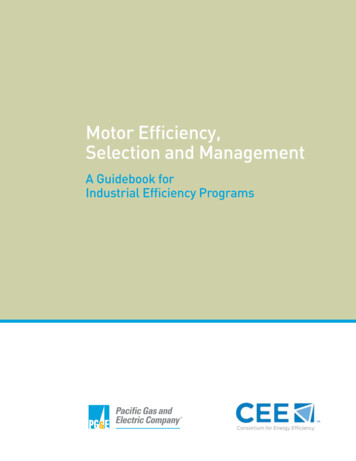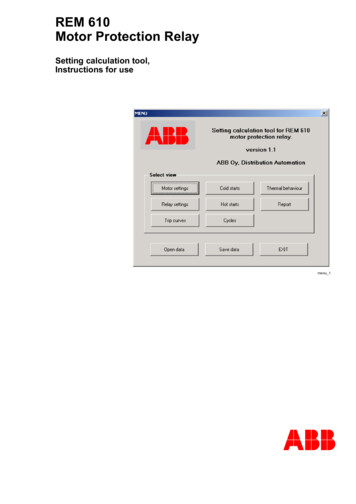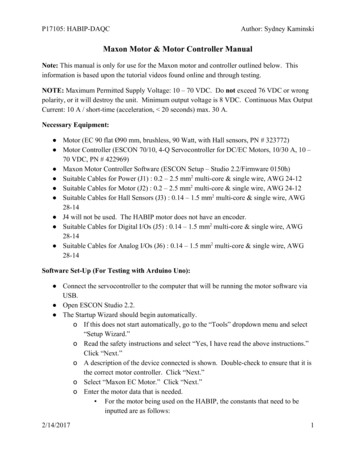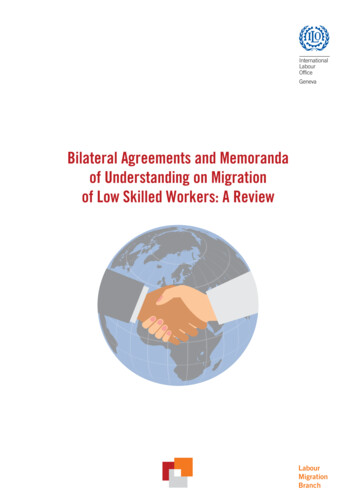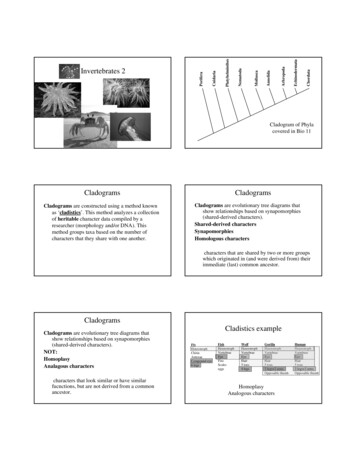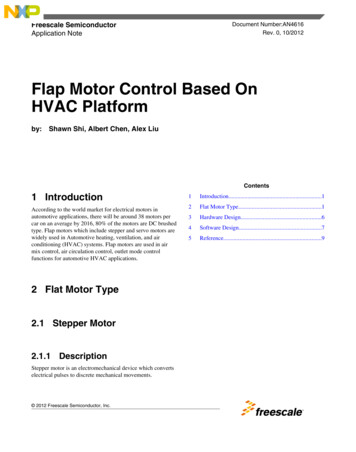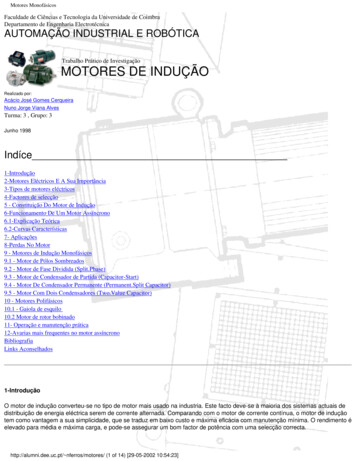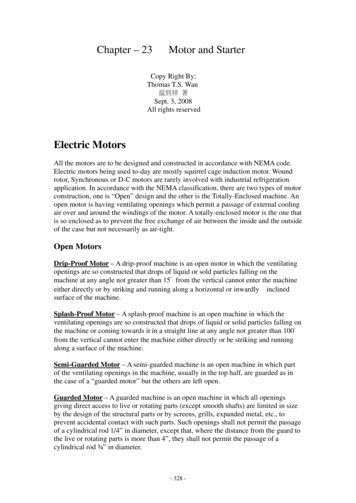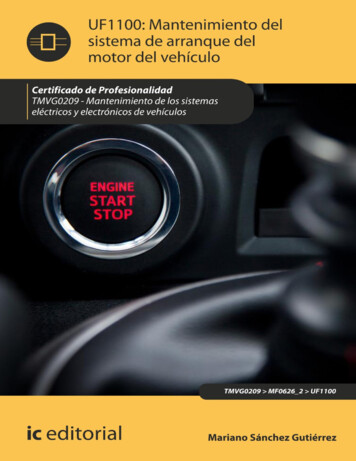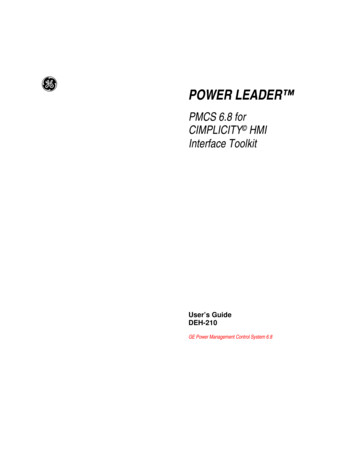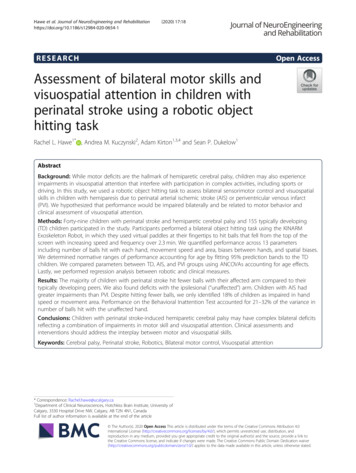
Transcription
Hawe et al. Journal of NeuroEngineering and 654-1(2020) 17:18RESEARCHOpen AccessAssessment of bilateral motor skills andvisuospatial attention in children withperinatal stroke using a robotic objecthitting taskRachel L. Hawe1* , Andrea M. Kuczynski2, Adam Kirton1,3,4 and Sean P. Dukelow1AbstractBackground: While motor deficits are the hallmark of hemiparetic cerebral palsy, children may also experienceimpairments in visuospatial attention that interfere with participation in complex activities, including sports ordriving. In this study, we used a robotic object hitting task to assess bilateral sensorimotor control and visuospatialskills in children with hemiparesis due to perinatal arterial ischemic stroke (AIS) or periventricular venous infarct(PVI). We hypothesized that performance would be impaired bilaterally and be related to motor behavior andclinical assessment of visuospatial attention.Methods: Forty-nine children with perinatal stroke and hemiparetic cerebral palsy and 155 typically developing(TD) children participated in the study. Participants performed a bilateral object hitting task using the KINARMExoskeleton Robot, in which they used virtual paddles at their fingertips to hit balls that fell from the top of thescreen with increasing speed and frequency over 2.3 min. We quantified performance across 13 parametersincluding number of balls hit with each hand, movement speed and area, biases between hands, and spatial biases.We determined normative ranges of performance accounting for age by fitting 95% prediction bands to the TDchildren. We compared parameters between TD, AIS, and PVI groups using ANCOVAs accounting for age effects.Lastly, we performed regression analysis between robotic and clinical measures.Results: The majority of children with perinatal stroke hit fewer balls with their affected arm compared to theirtypically developing peers. We also found deficits with the ipsilesional (“unaffected”) arm. Children with AIS hadgreater impairments than PVI. Despite hitting fewer balls, we only identified 18% of children as impaired in handspeed or movement area. Performance on the Behavioral Inattention Test accounted for 21–32% of the variance innumber of balls hit with the unaffected hand.Conclusions: Children with perinatal stroke-induced hemiparetic cerebral palsy may have complex bilateral deficitsreflecting a combination of impairments in motor skill and visuospatial attention. Clinical assessments andinterventions should address the interplay between motor and visuospatial skills.Keywords: Cerebral palsy, Perinatal stroke, Robotics, Bilateral motor control, Visuospatial attention* Correspondence: Rachel.hawe@ucalgary.ca1Department of Clinical Neurosciences, Hotchkiss Brain Institute, University ofCalgary, 3330 Hospital Drive NW, Calgary, AB T2N 4N1, CanadaFull list of author information is available at the end of the article The Author(s). 2020 Open Access This article is distributed under the terms of the Creative Commons Attribution 4.0International License (http://creativecommons.org/licenses/by/4.0/), which permits unrestricted use, distribution, andreproduction in any medium, provided you give appropriate credit to the original author(s) and the source, provide a link tothe Creative Commons license, and indicate if changes were made. The Creative Commons Public Domain Dedication o/1.0/) applies to the data made available in this article, unless otherwise stated.
Hawe et al. Journal of NeuroEngineering and Rehabilitation(2020) 17:18BackgroundPerinatal stroke is the most common cause of hemiparetic cerebral palsy (HCP) [1]. Motor deficits have beenwell documented in the hemiparetic upper extremity,and include weakness [2–4], spasticity [5–7], and impaired selective motor control [8–10]. Additionally,many individuals have proprioceptive deficits [11–13].Previous work has also established that deficits are notisolated to the contralesional side as impairments canoften be found bilaterally [14–16]. While clinical assessments and research studies typically focus on reachingand grasping performance [17], real-world situationsoften require more complex actions. For instance, in aclinical assessment a child may be attempting to pick upa single block off a table, while in the real-world a childis trying to catch a fast-moving ball that may come fromany direction within a field full of distractions. In contrast to the clinical assessment, this complex real-worldactivity requires not only preserved motor and sensoryfunction bilaterally, but also the ability to use visuospatial skills to make rapid motor decisions. In order tobetter target treatments and measure change, assessments must address these complex skills.Outside of sensorimotor impairments, HCP can impact a number of neural processes including visuospatialattention. Visuospatial attention refers to the cognitivefunction of attending to relevant environment stimuliwhile ignoring irrelevant stimuli, and consists of theprocesses of alerting, orienting, and executive control[18]. Deficits in visuospatial attention in children withHCP have been previously documented using primarilypencil and paper tests, with a recent study finding thatover 60% of a sample of 75 children with HCP failed atleast one test of visuospatial attention [19]. While visuospatial attention deficits are found in children with bothright and left hemispheric damage, deficits may be morecommon and severe when the right hemisphere isaffected [20, 21]. Right hemisphere damage is morecommonly linked to left egocentric neglect (neglect ofspace to the left of body’s midline) [19], whereas the deficits with left hemisphere lesions may be more bilateral[19–21] and exacerbated by more complex tasks [20]. Inan attention task involving listening, both right and lefthemisphere lesions had deficits in shifting attention between sides [22]. The type of lesion may also impactvisuospatial attention deficits, with deficits being moreprevalent in children with cortical/subcortical lesions(arterial stroke) compared to periventricular (venous)lesions, possibly due to the regions damaged [19]. Whilevisuospatial attention is a known prerequisite to movement, the interplay between deficits in attention andmotor impairments in HCP is not well understood.Robotic tasks have the advantage of being able to integrate visuospatial attention demands with motor tasks inPage 2 of 12a controlled manner to precisely monitor participants’performance. A robotic object hitting task has been previously developed and applied to adults with stroke toassess bilateral motor performance and visuospatialattention, and found to correlate with the Functional Independence Measure and Behavioral Inattention Test[23]. In this task, participants use virtual paddles on theends of both hands to hit away virtual balls that fall withincreasing speed and frequency. Good performance onthe task, as measured by hitting as many balls as possible, therefore requires integration of visuospatial attention and motor skills.In this study, we employed a robotic object hittingtask to quantify performance in children with hemiparetic cerebral palsy due to either a perinatal arterialischemic stroke (AIS) or periventricular venous infarct(PVI) compared to typically developing (TD) children.We examined how success on the task (i.e. numberof balls hit) related to motor behavior during the task,namely hand speed and movement area, as well as toperformance on a more simplistic visually guidedreaching task. We also looked at the relationshipbetween clinical measures of both motor and visuospatial attention with performance on the object hitting task. We hypothesized that performance on thetask would be impaired bilaterally in children withHCP, and correlate with both motor behavior andclinical assessment of visuospatial neglect.MethodsParticipantsWe recruited participants with hemiparesis due toperinatal stroke to participate in this study from apopulation-based cohort (the Alberta Perinatal StrokeProject) [24]. Inclusion criteria were: 1) age 6 to 19years old; 2) MRI confirmation of unilateral perinatalstroke (AIS or PVI); 3) clinical confirmation of symptomatic hemiparesis; 4) gestational age 36 weeks; 5)visual acuity of at least 20/50; and 6) written informed consent/assent. Exclusion criteria were: 1)multifocal stroke; 2) other neurological disorders notattributable to perinatal stroke; 3) Manual AbilitiesClassification System grade V; 4) severe spasticitydemonstrated by Modified Ashworth Scale 3 in theupper extremity; 5) inability to comply with the studyprotocol; 6) upper extremity surgery, botulinum toxintreatment, constraint induced movement therapy, orbrain stimulation therapy within 6 months of studyparticipation.Typically developing (TD) children between the agesof 6 and 19 with no history of neurologic impairmentalso completed the same robotic assessments as theparticipants with hemiparesis. All provided writteninformed assent or consent. The University of Calgary
Hawe et al. Journal of NeuroEngineering and Rehabilitation(2020) 17:18Page 3 of 12Conjoint Health Research Ethics Board approved thisstudy.Robotic assessmentsParticipants completed standardized robotic assessments using the KINARM robotic exoskeleton(Kinarm, Kingston, Ontario) as shown in Fig. 1a. Participants sat in a wheelchair base modified to accommodate pediatric participants. Adjustable troughssupported the arms in the horizontal plane. The robotallowed for free elbow and shoulder movement in thehorizontal plane. A horizontal display provided augmented reality.Object hit taskFor the object hitting task, children used virtual paddlesdisplayed at their fingertips. Balls moved towards thechild from the top of the screen from one of 10 horizontal locations or bins. We instructed the children to hit asmany balls as possible with either hand. The workspaceis depicted in Fig. 1b. The robot delivered a small hapticforce pulse when the ball contacted the paddle. Themagnitude of the force varied based on the ball’s acceleration following the hit, however in general was less than5 N. Balls fell with increased speed and frequencythroughout the 2 min and 18 s of the task, for a total of300 balls. The object hitting task in adults has beenpreviously described in detail [23].We quantified performance on the task using 13parameters described below [23, 25]. We refer to individuals with perinatal stroke as having an “affected”(hemiparetic) arm and an “unaffected” arm based ontheir clinical assessments. We acknowledge that whilewe are using the terms “affected” and “unaffected” forbrevity, motor deficits have been found bilaterally inchildren with hemiparesis [14, 15]. For TD participants, we operationally use the terms “affected” asanalogous to “non-dominant” and “unaffected” to“dominant”.Overall Performance Parameters:1) Total Hits: Total number of balls hit by either handout of maximum of 300 balls2) Hits Affected: Number of balls hit by the affectedhand3) Hits Unaffected: Number of balls hit by unaffectedhandSpatial and Temporal Performance Parameters:4) Miss Bias: Quantifies spatial bias in misses towardsone side of the workspace or the other. A weightedmean is calculated (shown below) based on thenumber of misses in each of the 10 bins along theFig. 1 KINARM exoskeleton and Object Hit task. a KINARMexoskeleton is shown with wheelchair base and arm troughs thatsupport arms in horizontal plane. We used adaptations includingbooster seats and smaller arm troughs as needed to accommodatesmaller children. b Depiction of the task workspace, with greenvirtual paddles displayed at the participant’s fingertips. Balls fell fromthe top of the screen from 10 different horizontal locationsx-axis that balls fall from and their position alongthe x-axis. To compare right and left affected sides,the we flipped the workspace for participants whowere left-side affected, thereby positive valuesindicate more misses toward the side of the affectedor non-dominant arm.
Hawe et al. Journal of NeuroEngineering and Rehabilitation(2020) 17:18P10miss bias ¼xi wm;iPi¼110i¼1 wm;iwhere i refers to the bin (horizontal location), xi refersto the x location of the ith bin and weight wm, i is thenumber of misses in the ith bin.5) Hand Transition: Describes the location in theworkspace where hand preference switches. Thisparameter uses a subset of bins consisting of binswhere both hands made hits, as well as oneadditional bin on each side of bins with overlappinghits. Weighted means of hit distributions for eachhand are calculated for this subset of bins. Theaverage of the weighted means for each hand isthen calculated to determine the location of thehand transition, as shown below:!P10x wx wiR;iiL;iþ Pi¼1 2Pi¼11010i¼1 wR;ii¼1 wL;iP10hand transition ¼xi refers to the x-location of the ith bin and weightwR(L), i refers to number of hits with the right (or left)hand in the ith bin. If the ith bin was not part of the specified subset, the weight was set to zero. If there were nobins with hits from both the right and left hands, thesubset of bins was defined to include the furthest rightbin in which hits were made with the left hand and furthest left bin in which hits were made with the righthand.As with miss bias, we flipped the workspace for participants who were left-side affected, so positive valuesalways indicate the transition was shifted toward the affected arm.6) Median Error: The percentage of the way throughthe task (based on number of balls) when 50% ofthe total misses occurred. For example, if aparticipant misses 80 balls during the task, themedian error is the ball number at which the 40thmiss occurred, divided by 300 (total balls). A highermedian error indicates that most errors occurredduring the later portion of the task when it wasmore difficult.Motor Performance Parameters:7) Hand Speed Affected: Mean hand speed of theaffected hand over the entire duration of the task(m/s).Page 4 of 128) Hand Speed Unaffected: Mean hand speed of theunaffected hand over the entire duration of the task(m/s).9) Movement Area Affected: Area of space covered bythe movements of the affected hand during thetask, as determined by defining a convex hull(polygon) that includes the boundaries of themovement trajectory of the affected hand (m2).10) Movement Area Unaffected: Area of space coveredby the movements of the unaffected hand duringthe task, as determined by defining a convex hull(polygon) that includes the boundaries of themovement trajectory of the unaffected hand (m2).Interlimb Asymmetry Parameters:11) Hand Bias of Hits: Quantifies asymmetry in hitsbetween hands, calculated as (Hits Unaffected –Hits Affected)/(Hits Unaffected Hits Affected).12) Hand Speed Bias: Quantifies asymmetry in handspeed between hands, calculated as (Hand SpeedUnaffected – Hand Speed Affected)/(Hand SpeedUnaffected Hand Speed Affected)13) Movement Area Bias: Quantifies asymmetry inmovement area between hands, calculated as(Movement Area Unaffected – Movement AreaAffected)/(Movement Area Unaffected MovementArea Affected)Visually guided reaching taskTo understand the relationship between performance onthe bimanual object hit task with a simpler motor task, wealso analyzed performance on a visually guided reachingtask. The full results of the of this task in the same cohorthave been previously reported [14]. In brief, childrenperformed center out reaches to one of 4 targets. For thisanalysis, we used the following parameters [26]:1) Reaction Time: Time from target appearing toonset of arm movement (s)2) Initial Direction Error: Angular deviation betweenthe straight-line path from center to peripheral target and the vector from the hand position at movement onset to completion of initial movement(degrees)3) Path Length Ratio: Ratio of total distance handtraveled from movement onset to offset tominimum distance between center and peripheraltarget4) Maximum Speed: Maximum hand speed betweenmovement onset and offset (cm/s)We selected these parameters to represent temporal(reaction time and maximum speed) and spatial (initial
Hawe et al. Journal of NeuroEngineering and Rehabilitation(2020) 17:18direction error and path length ratio) components ofmovement that were hypothesized a priori to impactperformance on the object hit task.Page 5 of 12NY) and Matlab 2015a (Mathworks, Nantick, MA) forstatistical analyses.ResultsClinical assessmentsParticipants with perinatal stroke completed a battery ofclinical assessments administered and scored by atrained pediatric occupational therapist.1) Assisting Hand Assessment: Assesses how effectivea child is at using their affected arm to completebimanual tasks, with focus on typical performancenot capacity. Scores are transformed to a logit-scaleranging from 0 (no use of affected arm) to 100 (fulluse of affected arm) [27].2) Melbourne Assessment of Unilateral Upper LimbFunction: Assesses reaching and graspingfunction with scores ranging from 0 (worst) to100 (best) [28].3) Behavioral Inattention Test: The conventionalsubset of tests includes the following 6 pencil andpaper tests of visuospatial neglect: line, star, andletter cancellation, line bisection, and figure copyingand drawing. The maximum score is 146, withscores below 130 being indicative of visuospatialneglect [29].ParticipantsTable 1 shows demographic and clinical characteristicsof participants. A total of 155 typically developingchildren and 49 children with perinatal stroke (28 AIS,21 PVI) completed the study. There was no significantdifference in age between the three groups (F 0.368,p 0.692).Age effects on performance on robotic object hit taskWe found significant effects of age in TD children fortotal hits, median error, hits affected, hits unaffected,hand speed affected, hand speed unaffected, movementarea affected, and movement area unaffected. Figure 2shows the age curves based on TD participants with 95%prediction bands, with AIS and PVI participantssuperimposed.Effect of affected sideComparisons between children with right arm affectedand left arm affected hemiparesis did not show any significant differences for any of the parameters, except formovement area bias (F 4.99, p 0.030), where childrenwhose left arm is affected had a greater movement areabias compared to children whose right arm is affected.Statistical analysisTo account for expected age-related changes [30], wedetermined age-predicted norms. For each parameter,we fit a second-order polynomial curve to the TD children’s performance across the age range and calculated95% prediction interval bands. We could then identifythe number of children with AIS and PVI that fell outside of the age-predicted norms. This allowed us to detect impairments on an individual level rather thanrelying on group differences. In addition to identifyingthe number of children with impairments, we comparedperformance on each parameter between TD children,children with AIS, and children with PVI using one-wayANCOVAs with age as a covariate. When we foundsignificant between-group differences, we conductedpost-hoc comparisons between groups using Bonferronicorrections for multiple comparisons (Bonferroni corrected p-value 0.05/3 0.017). To determine the impact of side of hemiparesis, we compared individualswith right arm affected to those with left arm affectedhemiparesis using ANCOVAs with age as a covariate.We completed regression analysis between hits witheach hand and hand speed and movement area duringthe OH task, as well as between hits with each hand andselected visually guided reaching parameters and clinicalassessments. We used SPSS 24 (IBM Corp, Armonk,Percentage of children with impairments on eachparameterFigure 3 shows the percentage of children with impairments on each parameter as identified by the 95%prediction bands. Overall, we identified a higher proportion of children with AIS as impaired compared withPVI. Total hits and hits with the affected hand had thegreatest percentage of impaired participants, notablywith over 80% of the AIS group impaired on hits withaffected hand. Hits with the unaffected hand was impaired in 43% of AIS and 14% of PVI. We identifiedfewer children as having impairments in the motor performance parameters (hand speed and movement area)for either hand, however, the bias between the hands forboth parameters did identify a significant portion of children as impaired. Interestingly, we did not identify anychildren as having impairments in miss bias, indicatingmisses were not systematically occurring on one side ofthe workspace.Group differencesFigure 4 shows age-adjusted group means and 95%confidence intervals for TD, AIS, and PVI groups foreach parameter. Between-group differences are described below:
(2020) 17:18Hawe et al. Journal of NeuroEngineering and RehabilitationPage 6 of 12Table 1 Demographic and Clinical 1015/6Affected ArmHandedness:1 A/13 L/141 R9 L/19 R11 L/10 RAge (mean years SD)12.5 4.012.4 4.011.7 3.8MACSMACS I: N 4, MACS II: N 16MACS I: N 8, MACS II: N 5BIT (mean SD)129 20.9139.0 5.5range: 56–145range: 122–146AHA (mean SD)Melbourne (mean SD)N 6 below cutoff for neglect ( 130)N 1 below cutoff for neglect ( 130)61.3 20.575.2 16.7range: 32–100range: 55–10069.1 20.889.4 11.1range: 31–100range: 64–100MACS Manual Ability Classification Scale, BIT Behavioral Inattention Test, AHA Assisting Hand Assessment. MACS, AHA, and Melbourne scores were unavailable for16 children (8 AIS, 8 PVI), and BIT scores were unavailable for 2 children (1 AIS, 1 PVI)Overall PerformanceWe found significant between group differences for totalhits (F 115.3, p 0.001), hits affected (F 131.7, p 0.001), and hits unaffected (F 40.4, p 0.001). For totalhits, AIS and PVI both had fewer hits than TD (TD vs.AIS: t 13.8, p 0.001; TD vs. PVI: t 8.2, p 0.001),and AIS had fewer hits than PVI (t 3.2, p 0.003).Hits with the affected hand showed the same pattern,with both AIS and PVI having fewer hits than TD (TDvs. AIS: t 14.4, p 0.001, TD vs. PVI: t 9.3, p 0.001)and AIS having fewer hits than PVI (t 2.8, p 0.008).For hits with the unaffected hand, AIS and PVI againhad fewer hits than TD (TD vs. AIS: t 8.4, p 0.001,TD vs. PVI: t 4.3, p 0.001), but no difference wasfound between AIS and PVI: t 2.5, p 0.017).Spatial/Temporal PerformanceWe did not find a between group difference for missbias. For hand transition, we found a significant betweengroup effect (F 4.554, p 0.012), however, no post-hoctests were significant. Median error showed betweengroup differences (F 58.4, p 0.001), with post-hoctests showing median error was reduced (errors occurring earlier in the task) in AIS and PVI compared to TD(TD vs. AIS: t 9.9, p 0.001; TD vs. PVI: t 5.7, p 0.001). AIS was not significantly different than PVI (t 2.4, p 0.020).Motor PerformanceThere was a significant between group difference forhand speed of the affected hand (F 17.2, p 0.001),with both AIS and PVI having decreased hand speedcompared to TD (TD vs. AIS: t 5.8, p 0.001; TD vs.PVI: t 2.6, p 0.010), however, there was no differencebetween AIS and PVI (t 2.0, p 0.051). Movementarea of the affected hand was also significantly differentbetween groups (F 10.4, p 0.001), however, only AISwas significantly smaller than TD (t 4.4, p 0.001). Wedid not find any between group differences for handspeed (F 0.635, p 0.531) or movement area (F 1.247,p 0.290) of the unaffected hand.Interlimb AsymmetryWe found a significant between group difference for handbias of hits (F 48.2, p 0.001), with both AIS and PVIhaving a bias of more hits with the unaffected hand compared to TD (TD vs. AIS: t 8.7, p 0.001; TD vs. PVI:t 5.9, p 0.001), though no difference in bias betweenAIS and PVI (t 1.4, p 0.165). Hand speed bias had significant differences between groups (F 42.2, p 0.001),with AIS and PVI showing greater bias compared to TD(TD vs. AIS: t 8.5, p 0.001; TD vs. PVI: t 4.6, p 0.001) but no difference between AIS and PVI (t 2.4, p 0.022). Movement Area Bias also had significant betweengroup differences (F 27.0, p 0.001), with AIS and PVIshowing greater bias compared to TD (TD vs. AIS: t 7.1, p 0.001; TD vs PVI: t 3.1, p 0.002), and AIS hadgreater bias than PVI (t 2.55, p 0.014).Relationship between motor behavior and hits during theobject hit taskWe performed regressions between motor performanceparameters (hand speed and movement area) and number of hits with each hand to determine the extent towhich the amount and speed of movement can explainsuccessful task performance (for example, is a child not
Hawe et al. Journal of NeuroEngineering and Rehabilitation(2020) 17:18Page 7 of 12Fig. 2 Age Curves. Age curves (solid black line) and 95% prediction bands (dotted lines) were calculated based on TD participants (grey circles).AIS participants are shown by the red diamonds, and PVI participants by the blue squareshitting balls because they simply are not moving their affected arm during the task?). Table 2 shows the resultsof the regression analyses (R2 and p-values). Within theobject hit task, the hand speed and movement areaaccounted for more of the variance in hits with eitherhand for the TD group compared to children withhemiparesis.found reaction time explained the most variance innumber of hits for either hand in the children withhemiparesis as well as the TD children. Initial directionerror and path length ratio were related to hits on theaffected hand for the TD and AIS groups, and with theunaffected hand for the TD and PVI groups. We did notfind maximum speed in the visually guided reaching taskto be related to hits for any group.Relationship between object hit and visually guidedreachingRelationship between object hit and clinical assessmentsWhen regressing the number of hits with selected parameters from the visually guided reaching task, weRegressions between clinical assessment scores and hitsfound that BIT scores accounted for 21–32% of the
Hawe et al. Journal of NeuroEngineering and Rehabilitation(2020) 17:18Page 8 of 12Fig. 3 Percentage of Children with Impairments. Children who fell outside the 95% prediction bands were determined to be impaired. For eachparameter, the percentage of the AIS (red) and PVI (blue) groups with impairments are shownvariance in hits with the unaffected hand, a greater contribution than found for the affected hand. The Melbourne and AHA accounted for over 47% of thevariance in hits with the affected hand for AIS, but didnot significantly relate to hits for the PVI group or hitswith the unaffected hand for either group.DiscussionThe aim of this study was to examine the ability of children with perinatal stroke and hemiparetic cerebral palsyto perform a bilateral object hitting task. This task requires the integration of both motor and visuospatial attention skills and provides insights beyond a typicalreaching task. We found that the majority of childrenwith hemiparetic cerebral palsy had deficits in their ability to hit the targets, despite only a minority having deficits in hand speed or movement area during the task.We found that children with AIS had greater impairments than those with PVI. The difficulty children hadin hitting the targets is likely a combination of bilateralmotor impairments and visuospatial attention deficits.While not the only factor, preserved motor function inthe affected arm is a key component for success (hittingmore targets) on the task. The majority (86% of AIS and57% of PVI) of children with HCP hit fewer targets withtheir affected hand compared to their typically developing peers. A simple explanation for hitting fewer targetsmight have been that these children moved their handswith a slower speed or over a smaller area. However, wefound that only a small fraction of the children with AISor PVI had impairments in hand speed or movementarea. Additionally, in TD children we found faster handspeed and larger movement area was related to hittingmore targets, however, these relationships were notfound in children with HCP. Regression analysis between select parameters from the visually guided reaching task and number of targets hit with the affected armcan give further insight into the extent to which motorimpairments can impact performance on this task. Reaction time, which has both motor and attentional components, correlated with hits in TD as well as AIS and PVI,though to a slightly lesser degree than TD. It is likelythat reaction time reflects an individual’s ability to rapidly attend to a new visual stimulus and form a motorplan, both of which are required to successfully hit thetargets in the object hit task. Initial direction error andpath length ratio, both of which relate to accuracy, explained 26–32% of the variance in targets hit for TD andAIS. However, these measures of accuracy were not correlated with hits for PVI. These findings suggest thatmotor deficits are not the only factor impacting a child’sperformance on the object hitting task.The object hit task also identified impairments in theunaffected (ipsilesional) arm, with children with HCP
Hawe et al. Journal of NeuroEngineering and Rehabilitation(2020) 17:18Page 9 of 12Fig. 4 Group Means. Age-adjusted group means and 95% confidence intervals are shown for each parameterhitting fewer targets with this arm compared to TD children. As with the affected arm, we did not find deficitsin movement speed or area on the task in the unaffectedarm. Deficits in the unaffected arm have been reportedpreviously, and have been hypothesized to reflectreorganization of the motor areas to the contralesionalhemisphere [14–16]. While children may demonstratecompens
Assessment of bilateral motor skills and visuospatial attention in children with perinatal stroke using a robotic object . We determined normative ranges of performance accounting for age by fitting 95% prediction bands to the TD . Performance on the Behavioral Inattention Test accounted for 21-32% of the variance in number of balls hit .

